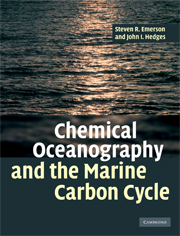Book contents
- Frontmatter
- Contents
- Preface
- Acknowledgements
- I Introduction to chemical oceanography
- 1 Oceanography background: dissolved chemicals, circulation and biology in the sea
- 2 Geochemical mass balance: dissolved chemical inflow and outflow from the ocean
- 3 Thermodynamics background
- 4 Carbonate Chemistry
- 5 Stable and radioactive isotopes
- 6 Life processes in the ocean
- 7 Paleoceanography and paleoclimatology
- II Advanced topics in marine geochemistry
- Index
- Plate section
- References
6 - Life processes in the ocean
Published online by Cambridge University Press: 05 September 2012
- Frontmatter
- Contents
- Preface
- Acknowledgements
- I Introduction to chemical oceanography
- 1 Oceanography background: dissolved chemicals, circulation and biology in the sea
- 2 Geochemical mass balance: dissolved chemical inflow and outflow from the ocean
- 3 Thermodynamics background
- 4 Carbonate Chemistry
- 5 Stable and radioactive isotopes
- 6 Life processes in the ocean
- 7 Paleoceanography and paleoclimatology
- II Advanced topics in marine geochemistry
- Index
- Plate section
- References
Summary
Patterns of chemical distributions within the ocean are primarily controlled by biological processes and ocean circulation. Major features of this biogeochemical mosaic include removal of nutrients from warm surface ocean waters, concentration of these same nutrients in deep-ocean waters, and depletion of dissolved oxygen at intermediate water depths. These patterns are imprinted as mixing and advection carry nutrient-laden water from ocean depths into the sunlit upper water. These nutrients are used during photosynthesis to generate particulate and dissolved products that sink or are mixed into the interior ocean, where they are respired back into dissolved metabolites. Interactions of these physical and biological processes occur on time scales of days to hundreds of years and are expressed by the vertical concentration profiles of a variety of dissolved chemical species throughout the ocean. The chemical perspective of oceanography involves using the distributions of metabolic products to derive information about the rates and mechanisms of ocean processes in this largely unobserved sphere.
The effects of life processes are felt in every chapter of this book. In this chapter we introduce the methods by which chemical tracers have been used to determine biological fluxes. We begin with a whole-ocean point of view in which chemical differences between the sunlit upper ocean and the dark deep waters are interpreted by using a two-layer model.
- Type
- Chapter
- Information
- Chemical Oceanography and the Marine Carbon Cycle , pp. 173 - 218Publisher: Cambridge University PressPrint publication year: 2008



